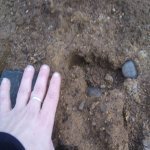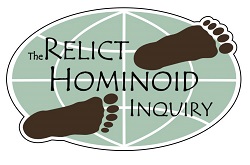Leaderboard
Popular Content
Showing content with the highest reputation on 04/30/2021 in all areas
-
I haven't seen anything from him recently, guessing he was done with the subject as well. But people still recycle the events and try to conform or rationalize it to their view. He may feel compelled to respond to some of it. The bottom line is in those moments of decision, Justin showed no regard for life. The issue is not, oh darn we lost an opportunity to get fresh dna. That would have been a minor victory by cold hearted folks thinking science gives a crap about validating their personal obsession. It was a tragic scene. He killed 2 living beings. Not animals for food or clothing or another means of survival. It wasn't even for sport. It was just callous murder. There are multiple sides to Justin. I've seen him not show emotion, like he's too vacant to comprehend the ramifications. Then I've seen him borderline breaking down emotionally from the enormity of it. Nothing good came of this. It's a stain on humanity.3 points
-
2 points
-
Our esteemed Steering Committee member and forum donor Incorrigible1 is celebrating 5000 likes!!! This is making forum history!🥂🥂🏆🎖 Please give him a pat on the back and congratulate him below for all his support to the BFF!!! It’s members like him that contribute to this forum and make it a success!!! Congrats Inc!1 point
-
I found a free infrasound detector app for Android phones. It uses the phone's microphone and accelerometer to detect/log infrasound between 4Hz and 30Hz. I'm thinking of taking it to the zoo when it reopens to see what happens.1 point
-
Congratulations Incorrigible1! And to you too norseman - for being darned close as well!1 point
-
Congratulations Incorrigible1! And thank you... for your support and effort here1 point
-
Not Paying Attention. Ken Walker found him and informed a few other famous dudes. Ken used to post here, among others, but you can't search old usernames anymore. Long ago for some reason, this forum disappeared inactive users, without explanation. Gigantor posted old threads with lots of details on page 3 of this one. Anyway, all those names haven't gone away, they're just on other platforms, or sometimes not as public. Use your typing skills and find out. https://www.youtube.com/watch?v=FnsqHrgz-Z8 https://www.youtube.com/watch?v=xg0Y4TaehVw Recent video featuring JS is around, even, appears to be taking himself very seriously. Now done with this tiresome topic.1 point
-
I feel that the sightings may not have increased but the reports have increased due to technology. The use of cell phones, the Internet, and social media just wasn't available back in the 1960s so many sightings went unreported or unnoticed. Thermal imaging cameras have finally come down in size and price for personal use. Further, we have hit a knee in social behavior where believing in Bigfoot or UFOs no longer generates instant ridicule. This helps people report incidents without fear of refute. They avoid infrared beams because they can see them. We would be wise to use this knowledge to our advantage. In addition to thermal devices, long range cameras and scopes offer additional technological advantage in spotting the creatures.1 point
-
Great find Gigantor. It would be very helpful to be able to confirm what your body is sensing. @Arvedis Were you in the woods, ,and removed society's noises, when you were testing it or in an urban/suburban environment?1 point
-
I understand. Both of my sister's kids are 25% Seneca. The older one is on the tribal roster; the younger one is not. The Seneca Nation changed the requirements in the 4-year span separating the two.1 point
-
Reprinted with Permission 4/29/2021 The RELICT HOMINOID INQUIRY 7:135-138 (2018) Comment LANGUAGE IN HIGHER PRIMATES RONALD COSPER Linguists have maintained that possession of language is a unique attribute of human beings. Earlier scholars claimed that humans invented language and learned to speak, passing this ability on to subsequent generations. More recently, the universality of language has convinced most linguists that language is a biologically based ability of human beings, and that we are genetically programmed to acquire language and speak. It has been discovered that although human languages differ considerably among themselves, they all have certain structural traits in common. If we are going to maintain that language is an evolutionary product, it is obviously important to study vocal communication in other species. Some primates are said to have systems of “calls,” and others communicate with various actions and displays. If sasquatch are a close human relative, it would be extremely important to understand their vocal communication. Such knowledge would revolutionize our understanding of human language. Linguistics could then become a truly comparative field of study, in which language would be seen as one type of communication that evolved in certain circumstances among some species. It may be true that sasquatch have vocal communication similar to language, as quite a few of the observational reports of sasquatch indicate. Of course, many of these reports are observations of single individuals, and it is unlikely that speaking would occur in these situations. However, when several sasquatch are present together, there are often reports of “languagelike” behavior. Also occurring are various other oral noises, less similar to articulated language, and more like noises or cries made by other species of primate. Long distance communication may also be carried on by sounds like whistles, howls, etc. One of the first such accounts was that made by Albert Ostman, a hunter/prospector who claimed to have been captured and carried off in the mountains of British Columbia. He described language-like behavior occuring within this small social grouping of an adult male and female, and two adolescent subadults. At one point, the adult male seemed to be encouraging Ostman to remain within the group by saying something like “soka, soka.” In another instance, one said something like “ook” when offered a cup of water. The most extensive transcript we have of purported sasquatch communication is the set of recordings made in the Sierra Mountains of California by Al Berry and Ron Morehead, and subsequently transcribed an analyzed by cryptolinguist Scott Nelson. These communications were allegedly made by a group of sasquatch in the woods around the hunting camp. Nelson has segmented these utterances into short sequences he calls “morphemes” and says they are composed of “phonemes.” These terms are descriptive terms used by structural linguists in analyzing human language. But in fact we know so little about sasquatch communication, that it really has not been established that their “language” is structured in this manner. For example, phonetic variation could be continuous and not divided into specific phonemes (as are some human utterances). These sequences of sounds that Nelson has identified as morphemes are really more properly called “syllables.” Since we do not know whether specifically defined meanings are associated with these syllables, we cannot call them “morphemes” with any assurance. I admire Nelson’s perseverance and skill at transcribing these unusual sounds. There is a general context, but not a great deal of associated behavior to figure out meanings for these utterances. From an evolutionary perspective, it is certainly interesting that a primate species rather similar to Homo sapiens (bipedalism, use of hands, utterance) seems to have a vocal communication system that includes something potentially similar to human language. This might suggest quite a close kinship with modern humans, although other anatomical features (height, breadth, strength, skull shape, arm length) may reflect an earlier branching. Perhaps the two traits of vocal “language” and well-developed bipedalism suggest a close relationship, and one in which these two traits evolved prior to a separation of these two species. Therefore, if vocal communication evolved only once for these species, it becomes more likely that they may share elements of form, meaning and use. Nelson suggests that these utterances could be compared to English. I see no reason to do this. We do know that English, depending on how it is defined, is only a thousand years old, or so. However, through historical comparison and reconstruction, linguists have been able to recreate earlier forms of the 6,000 plus extant human languages. For example, it is quite easy to recreate Proto-Germanic, the ancestor of all Germanic languages, including English, Dutch, Gothic, Norse, and so on. ProtoGermanic must have been spoken in Northern Europe two to three thousand years ago. Similarly, Proto-Slavic, Proto-Italic, ProtoIndoIranian, have a comparable time depth. These groups are all part of ProtoIndoeuropean, which was probably spoken perhaps 8,000 years ago in Anatolia, or north of that on the steppes of Eurasia. Similarly, around the world other language “families” have been studied, such as Afroasiatic, SinoTibetan, Penutian, and so on. However, even these time depths are a far cry from the date we would have to go to help understand a hypothetical “proto-human/ sasquatch,” an unknown date which could be a matter of a couple of million years, or more. Now some comparative linguists have undertaken the task of reconstructing the reconstructions. For example, the late Joseph Greenberg has grouped several of these families into a Eurasiatic macro-family. Others have maintained that all the African languages are ultimately related, and Greenberg groups all the Amerindian languages (except Eskimo-Aleut, and Athabaskan) into a single macro-family. A grouping called Nostratic has been proposed, along with other macro-families. The macro-families, if correctly analyzed, can push the date of human languages back perhaps 20,000 years. Now some historical linguists maintain it is likely that human language evolved only once, and that at the beginning all humans spoke the same way. A few researchers, such as Shevoroskin and Ruhlen, have claimed that by analyzing these macro-families, using the technique of “mass comparison” it is possible to reconstruct “Proto-World,” or the original language of all humans. Now we have something that may go back hundreds of thousands of years. If we are going to compare sasquatch speech with human language, we certainly have to use an earlier form, and if language evolved only once, then Proto-World is the one to compare it to. Linguists do not appear to be any less critical of each other’s work than any other academics, and some would say that linguists, as a group, tend to be highly critical of one another. Historical and comparative linguistics is a little out of favor right now, although the field is probably as well-developed as most other areas of linguistics. In fact, the farther back in time the comparisons go, the louder the chorus of criticisms. Some would say justifiably so, while others point to the vested interests of academics with differing ideas. Greenberg’s Amerindian was widely doubted by Americanists, who have always resisted larger groupings, in spite of the great success of his earlier African classification. But a good deal of scorn was heaped on Ruhlen and others, despite their evidence, to the extent that some of their works on the subject were never published. They stated that they had come up with 137 Proto-World constructions. Unfortunately for us, only a couple of dozen of these have seen the light of day in subsequent publications. At this point, I can propose one Sasquatch word. Ook, as recorded by Ostman, may mean “water” (“drink” or related meanings are also possible). Ruhlen, et al., reconstructed the human Proto-world form as akwa. This root shows up throughout the world in modern forms, some of which sound a lot like uk or ku (In Old English, the two words for “water” were /wæter/, literally “that which is wet” and /ēa/ from the akwa root). I have so far not been able to find anything close to soka. Additional searching through comparative materials may help yield an interpretation. In the future, the question of dialectal variation must also be considered. In the present day, human language changes pretty much continuously, and groups out of touch with each other rapidly developed different dialects, and, ultimately, different languages. Sasquatch reputedly occupy a large territory (North America?), and we may not be able to expect that their verbal communication will be the same over the entire area. On the other hand, mobility, inter-communication, and limitations of the system may tend to stabilize the language of sasquatch over their range. The experiences in the case of the Sierra recordings and of Ostman in British Columbia suggest that further successful research on sasquatch communication would be similar to that of present day anthropological fieldwork and of primatological field research on chimpanzees and gorillas, in that it is important to establish trust and familiarity among those you are studying. Such a relationship would be difficult, but probably not impossible to establish in the case of sasquatch, for only in that way can a sympathetic understanding of their lifeways be attained. Especially in cognitive matters and communication, intimate contact is required. Ronald Cosper Halifax, Nova Scotia LITERATURE CITED Greenberg JH, Language in the Americas. Stanford: Stanford University Press, 1987. Greenberg JH, "The Convergence of Eurasiatic and Nostratic." Pp 331-340, In Greenberg JH, Genetic Linguistics. Essays on Theory and Method. Edited and introduced by William Croft. Oxford: University Press, 2005. Morehead R, Voices in the Wilderness; A True Story, 2 nd edition. (self-published) 2013. Nelson RS, “Sasquatch Phonetic Alphabet” Presentation to Oregon Bigfoot Symposium, June 19, 2010. http://www.nabigfootsearch.com/Bigfootlanguage.html Ostman A, “The Albert Ostman Story.” In: John Green, The Apes among Us. British Columbia: Hancock House, 1970. http://www.bigfootencounters.com/ Ruhlen M, The Origin of Language: Tracing the Evolution of the Mother Tongue. New York: John Wiley and Sons, 1994. Ruhlen M, On the Origin of Languages: Studies in Linguistic Taxonomy. Stanford, CA: Stanford University Press, 1994. Salmons JD and BD Joseph, Nostratic; Sifting the Evidence. Amsterdam: John Benjamins Publishing Company, 1998. Shevoroshkin VV and TL Markey, Typology, Relationship and Time. Ann Arbor, MI: Karoma Publishers, 1986. Ronald Cosper received a B.A. from Purdue University, an M.A. from Cornell in sociology and linguistics, and a Doctorate from Rutgers University, where he studied sociology and anthropology. He has done linguistic fieldwork on several languages, including Haitian Creole, Kewa of New Guinea, and a number of languages of northern Nigeria. He is author of numerous papers and publications some of which deal with evolution of language, lexical change in language (Semitic and Egyptian), phonetic symbolism, use of language in Nova Scotia, reading in Canada, and computer analysis of grammar. He has studied human evolution throughout his career, and recognized that the discovery of another species of hominid similar to ourselves would be extremely important to our understanding of our place in the world.1 point
-
Who else but the She Squatchers would be ready to figure this one out. They looked genuinely bored. Here are my notes: 0-10:00 Igor's bigfoot background going back to the 70s. Igor claimed to investigate up to 40 braided horse manes which be attributes to Bigfoot. 16:00 Igor blows his nose. The She Squatchers politely smile 19:00 begins to address the phone call at the 2021 Nebraska conference. The call came from a guy named Alexei in Bashkortostan which is in southern Russia. The Bigfoot in question is already known to Igor who says Alexei introduced him to a clan of Bigfoots. It is not clear if interactions are on Alexei's property or some other area. Alexei named the male alpha Gregory (or Grischa is a Russian language derivative of Gregory). Alexei said the Bigfoots told him they are between 150-200 years old and this clan ranges between 7-10 feet tall. There is implied mindspeak but also verbal communication among Alexi and the Bigfoots. The Bigfoots don't allow being photographed but Alexei has managed to get a few which he has shared with Igor. Igor says the Bigfoots have flat noses, a protruding mouth and look human, just covered in hair. He calls them "secret tribal humans" capable of poltergeist activity. Igor mentioned MK Davis and his work enhancing images for Russian researchers. MK theorizes BF to be a mix of human, neanderthal and denisovan. 28:00 The she squatchers explain to Igor the concept of a break in the podcast 32:20-36 Igor's long winded explanation of technical problems getting the phone call going 36:40-49:00 Igor imitates Gregory the BF and says BF trusts him and the phone call was genuine. That was Bigfoot speaking to us with a greeting and telling us that humans are severely destroying their habitat. Igor explains his bond with Gregory. He claims to have shook hands with him. Gregory also allowed Igor to examine his arms. 49:00 Scott Nelson studied a BF language discovered by Robert Carter Sr in Tennessee (Igor investigated the site in 2004) 50:00 details on new film documentary on Igor and other topics 100: Marie-Jeanne Koffmann and women in bigfoot research.1 point
-
Most places I know? It’s not illegal to shoot a cub. It’s frowned upon, but not illegal. Bears don’t grow antlers to tell sex and age. So there is no simple demarcation line with bears. A good guide can tell sex and age just by looking at a bear. But many hunters cannot.1 point
-
Love that country. In ‘87 I was a dumb Eastern kid who had never set a boot to ground west of Memphis. So, not feeling like I was getting any younger, I hopped a flight to Denver, a midnight bus to Rock Springs and thumbed to the Green River Lakes trailhead. With a xerox copy of Finis Mitchell’s hand-drawn map as my only navigational, I wandered for 10 days down to Big Sandy. Ain’t been right in the head since. 😀1 point
-
Still not seeing @Daniel Perez listed on the schedule at http://ohiobigfootconference.org/speakers.html. You never know though. This could be a rare conference speaking appearance by Danny. It appears sold out now anyway and not seeing a Zoom option on their site. Perhaps one day we will see the full Danny Perez conference speaker experience.1 point
This leaderboard is set to New York/GMT-05:00













